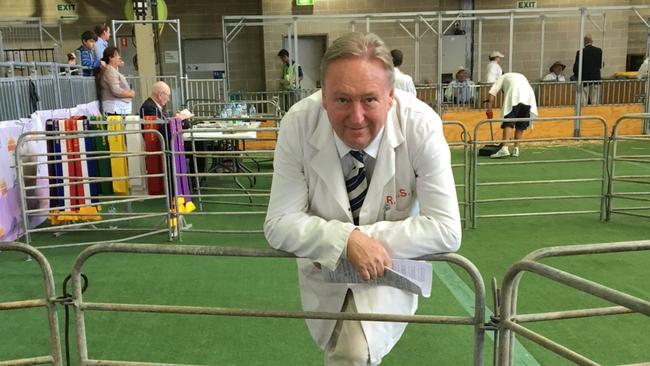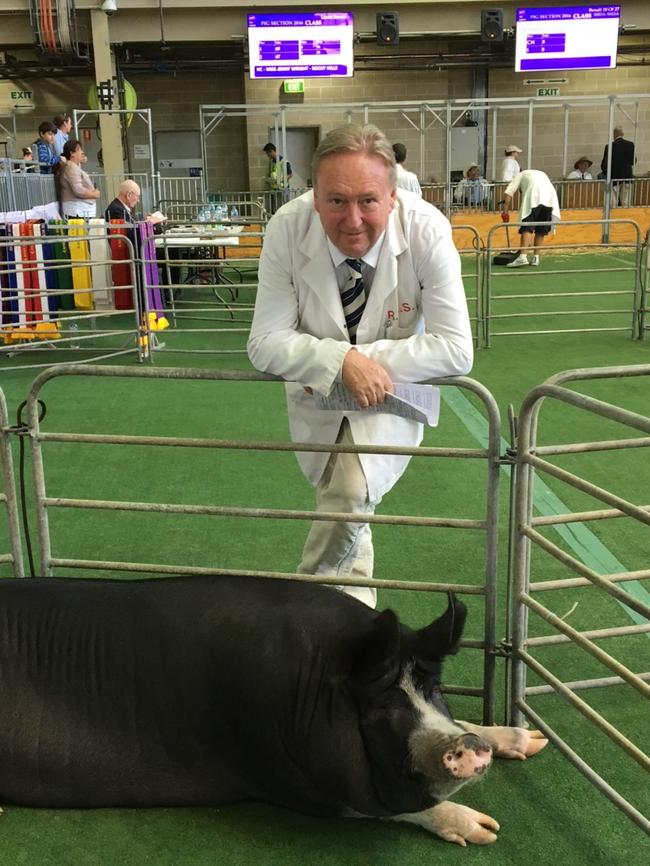Paddock or plate, love ’em
Inside the secret pig world, I have learned to love the live creatures, too.

The corridors of the Council Stand at the main arena of Sydney Olympic Park lead you back in time, past fading photographs of sepia-toned men, all jutting jaws and luxuriant moustaches.
The councillors of the Royal Agricultural Society, founded in 1822, were exclusively male for 170 years. Their wives were encouraged to lend a hand at the Sydney Royal Easter Show, perhaps judging cakes and scones, or helping with the flower displays.
Things changed with the arrival of the first woman on council in 1993, and while the floodgates haven’t exactly opened, today six of the Easter show’s 15 committee chairs are women, including my wife, Sally Evans, who heads the Sydney Royal Wine Show.
So it was that some years ago I found myself at an RAS dinner being gently ribbed about what spousal contribution I might make in support of my newly elected councillor wife.
I thought carefully about how I could appear enthusiastic, yet unavailable.
“The trouble with being a journalist,” I said, with just a hint of self-importance, “is that you never know what you’re going to be doing. The only day I can guarantee to be free is a Saturday.”
The table nodded their understanding, so I played my trump card.
“Besides,” I said, “the only animals I really like are pigs.”
A squat, solid, elbow-patched farmer with an angry red face looked up and beamed at me.
“You’re in luck!” he shouted. “Pig judging’s on a Saturday. You can be a steward.”
A few weeks later, a folder arrived with all the forms required to admit me to the ranks of RAS volunteers; then, early one March Saturday morning, I was showing my steward’s badge at the trade entrance of the Easter Show to join my goat, alpaca and pig colleagues.
When I had told Sally’s fellow councillors I really liked pigs, what I meant, of course, was I really liked dead pigs, on my plate.
They were chops, roast shoulders, pork belly, bacon, black pudding and hams: boiled, baked or cured. I have hunted down prosciutto, Portuguese presunto, jambon de Bayonne, lacon gallego from Galicia, Tyrolean speck and every kind of Spanish ham, from the humble serrano to the wildly expensive jamon iberico from the Iberian Black pigs that roam the oak forests of Extremadura and fatten themselves on acorns (they can eat 10kg a day). The finest brands cost upwards of $700 a kilo.
But inside the secret pig world, I have learned to love the live creatures, too. They are powerful and clever, examining the fences enclosing them and using their snouts to lift the rails, even with a hapless steward trying to weigh them down, to the delight of the watching crowds.
And when they decide to go somewhere, good luck stopping them. Their handlers, wielding heavy plastic screens like tea trays, try to direct them into stalls or turn them to present their best features to the expert judge, but a couple of hundred kilos of single-mindedness is not easily deterred.
Despite the bad press, pigs are clean animals and, left to themselves, keep their toilet and sleeping arrangements well separated.
In the confines of the show ring, however, they have no choice but to abandon their manners, and defecate and urinate with carefree enthusiasm, drawing squeals of joy from passing children and sighs of resignation from the steward charged with cleaning up (not me; my shoes are far too nice). Yes, it’s fun for all the family!

Just as the RAS is a link to our past, so too is the pig show. In the 1960s, there were 50,000 pig farms of all sizes in Australia; today, while we produce more pork, it comes from fewer than 1500 businesses, many of them industrial-scale piggeries that rear their animals in sterile warehouses, far from the picture-book farmyard.
But the Easter Show brings those old farms to town, with devoted lovers of Tamworths, Wessex Saddlebacks, Berkshires and the other five breeds currently in Australia keeping the tradition alive, even as their numbers continue to dwindle.
Live pigs and breeding material can no longer be imported, so while these restrictions protect against various diseases, genetic diversity inevitably shrinks, and breeds disappear: 20 years ago, the Welsh pig followed the China Poland and Gloucester Old Spot to become an Australian memory.
But as long as those breeders battle on, and as long as the show will have me, I will continue to volunteer my services to my porcine friends. Given how many of them I eat, it’s the least I can do.




To join the conversation, please log in. Don't have an account? Register
Join the conversation, you are commenting as Logout